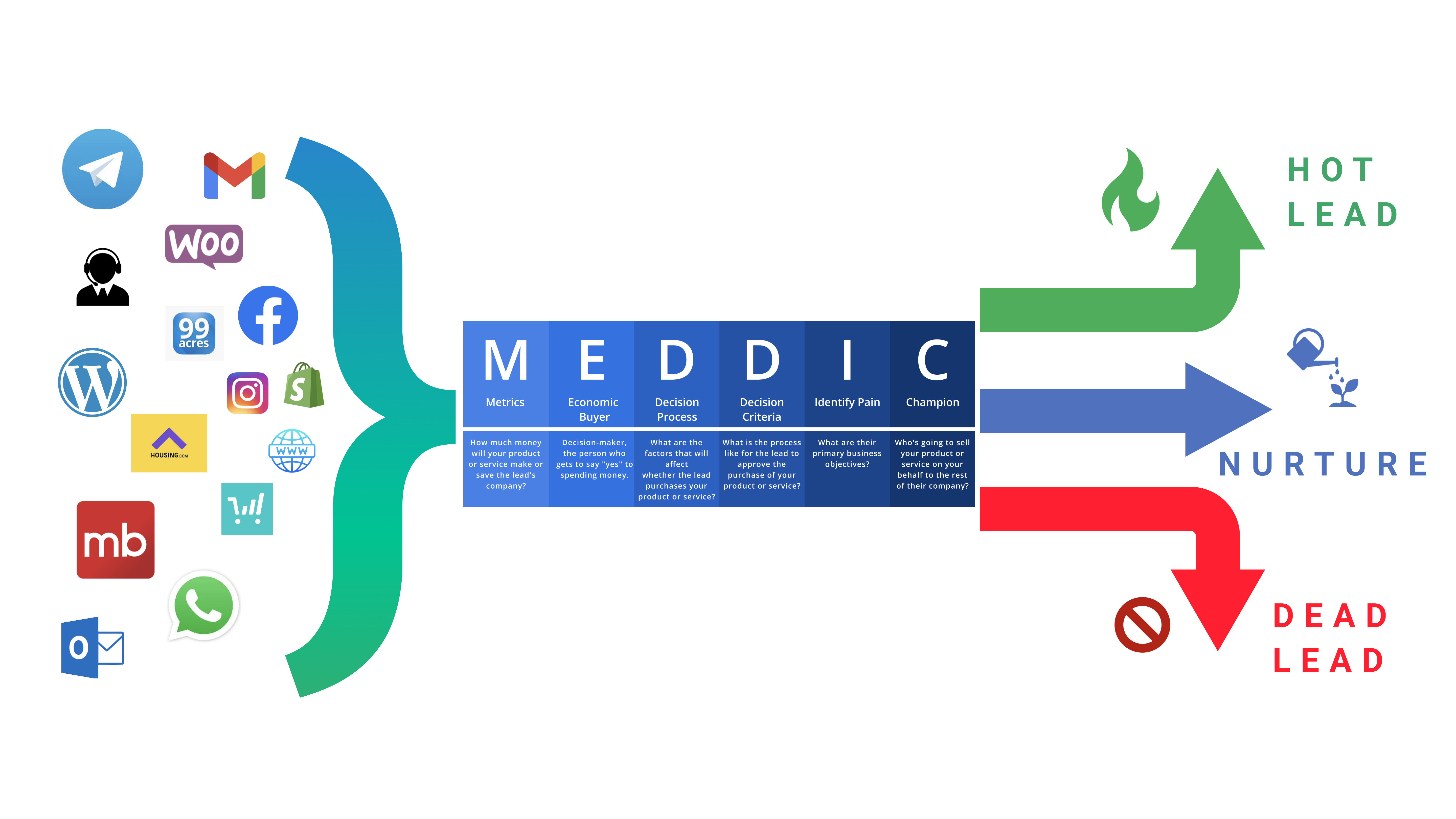MEDDIC: A Comprehensive Lead Qualification Framework


In the sales world, success hinges on the right pitch or skilled salespeople and identifying suitable leads. Lead generation is challenging, but the real test lies in qualifying those leads as potential sales prospects. This process demands time, research, and direct engagement. Thankfully, several strategies and frameworks ease the burden and improve lead qualification, even in today's challenging economic climate. One highly regarded methodology is MEDDIC, encompassing Metrics, Economic Buyer, Decision Criteria, Decision Process, Identify Pain, and Champion. In this article, we delve into the origins, framework, benefits, drawbacks, and practical applications of MEDDIC as a lead qualification approach.
Origin and History:
MEDDIC was developed by Jack Napoli, and Dick Dunkel during his time at PTC (Parametric Technology Corporation) in the 1990s. MEDDIC remains relevant and widely used in sales processes today due to its better buyer-focused approach and adaptability to various industries.
Many significant firms still utilize MEDDIC as part of their lead qualification process. Companies like Salesforce, IBM, and Oracle have incorporated MEDDIC into their sales methodologies. These organizations recognize the value of a comprehensive framework like MEDDIC to ensure that their sales teams effectively qualify leads and drive successful outcomes.
Framework:
The MEDDIC framework consists of six key elements:
- Metrics: Understanding the lead's key performance indicators (KPIs) and metrics helps sales teams align their offerings with the lead's quantifiable business objectives. To close the sale, understand customer goals in measurable terms. Use these metrics to demonstrate economic benefits and a strong ROI for your solution, increasing your chances of success.
- Economic Buyer: Identify the economic buyer with decision-making authority to close sales successfully. Understand their expectations and metrics to convince them, even if you can't directly interact with them.
- Decision Criteria: Understand the company's decision-making criteria, such as simplicity, integration, budget, and ROI. Please encourage them to formalize these criteria, demonstrating how your solution meets their needs and justifying the sale.
- Decision Process: Understanding the decision process is vital to prevent sales stagnation. Know the decision-maker, timeline, and approval processes. This knowledge enables targeted actions to meet conditions and close the sale efficiently.
- Identify Pain: Identify the customer's pain points and needs. Understand how your solution addresses these issues and provides relief. By being precise about their pain, you can present a compelling pitch tailored to their situation and motivate them to choose your solution.
- Champion: Identify a champion within the company who is invested in your success and motivated to advocate for your solution. Their influence and respect can significantly impact your ability to close the sale successfully.
Advantages:
MEDDIC offers several advantages as a lead qualification framework:
- Comprehensive Checklist: Ensures all necessary information is gathered, reducing the chance of overlooking critical details.
- Easy to Implement: Simple acronym suits individuals with limited sales experience.
- Improved Prospect Qualification: Better identifies and qualifies prospects, especially in complex B2B sales.
- Efficient Resource Allocation: Focuses on qualified leads, optimizing time and resources for improved ROI and cost savings.
- Accurate Sales Forecasting: Filters out unwinnable leads, enabling more precise sales forecasting and pipeline management.
- Comprehensive Evaluation: Considers multiple dimensions for lead qualification, ensuring all relevant factors are assessed.
- Strategic Alignment: Align sales approach and messaging with the lead's objectives, increasing relevance and effectiveness.
- Improved Sales Forecasting: Enhances forecasting accuracy by systematically evaluating lead's likelihood of conversion, aiding resource allocation.
Disadvantages
While MEDDIC is a valuable lead qualification framework, it does have some limitations:
- Time and Resource Intensive: Implementing MEDDIC requires substantial time and effort from sales teams. The comprehensive nature of the framework may involve extensive research and discovery calls to gather the necessary information for each lead, which can impact productivity and efficiency.
- Complexity: MEDDIC's comprehensive framework may be challenging to implement for organizations with limited resources or inexperienced sales teams. The framework's complexity and the need for an in-depth understanding of each element may pose challenges in its effective execution.
Summary:
MEDDIC, focusing on metrics, economic buyers, decision criteria, decision process, pain identification, and champion, offers a comprehensive and strategic lead qualification framework. It provides a structured approach to evaluating leads, aligning sales efforts, and improving sales forecasting accuracy. However, organizations should consider the potential time and resource constraints associated with implementing MEDDIC.
Action Points:
- Implementing a MEDDIC Lead Scoring Framework on Pronnel: Know More About How You Can Implement a Lead Scoring Mechanism on your Lead Management Board in Pronnel.
- Read more about how you can guide an exploratory Sales discussion to Qualify Leads Based on the MEDDIC Framework. What questions can you ask? How?
- Learn about other Lead Qualification frameworks like BANT, ANUM, FAINT, CHAMP, GPCTBA/C&I
Subscribe To Our Blogs
Get the latest blog notification into your email.